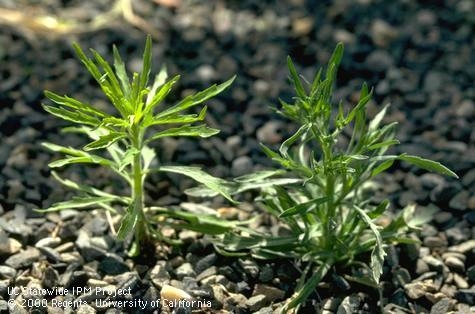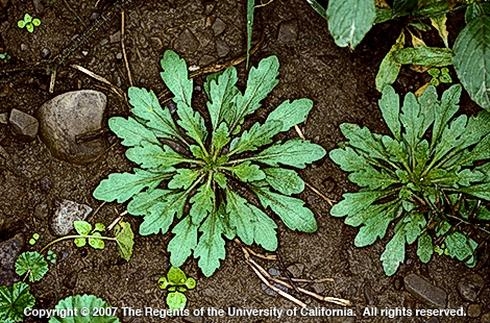It is not always easy to kill weeds with herbicides for several reasons, but if you apply the right material at the right time to susceptible weeds you expect control. But you should never assume it, because resistant weeds rely on this assumption.
Repeated use of herbicides with the same mode of action (usually the same target site within plant) selects for naturally occurring resistance traits in weed population. The few resistant weeds proliferate since there is no longer competition from susceptible types and if other control measures are not used.
Hairy fleabane (Conyza bonariensis) resistance to the two most commonly used herbicides – glyphosate (Roundup) and paraquat - is widely reported in California, including Ventura County. A close relative – horseweed or mare’s tail (Conyza canadensis) has wide-spread glyphosate resistance, as well.
These weeds are most frequently found at road sides, ditches and just about every site with infrequent disturbance. Of course, that is where glyphosate and paraquat are routinely applied. What’s worse, they produce thousands of wind-dispersed seeds that travel up to 3 miles and carry the herbicide resistance in them to new places. In fact these and other wind-dispersed weed species are increasingly common in our agricultural and urban areas because we fail to control them before seed production. The seed germinate on moist soil surfaces without incorporation and rapidly grow and reproduce.
There are several strategies to manage these herbicide resistant weeds that can be combined:
- Identify what species of weeds you have and select management options specific to your weeds and crop. You can look up susceptibility of weeds to herbicides for most crops at http://www.ipm.ucdavis.edu/PMG/crops-agriculture.html. These susceptibility tables are based on results of University of California research trials in those crops and are updated periodically.
- Always evaluate the efficacy of your herbicide application and look for weeds that escaped treatment. If one or two species survived treatment – they are likely resistant. If most weeds did - perhaps there was a general problem with herbicide application.
- Control weeds when they are small. Large mature weeds are more difficult to kill with herbicides but even resistant weeds can be controlled with herbicides when small. These weeds only reproduce by seed, if you see them flowering it may be already too late.
- To control escaped weeds use herbicide with a different mode of action appropriate to your crop/non-crop site.
- Use mechanical methods of weed removal – there has not been reported resistance to a cultivator or hoe
- Be a good neighbor – communicate with land-owners near you about the wind-dispersed weeds traveling between nearby properties and control them. Even if you manage weeds very well, wind dispersed species can travel to your site from surrounding areas, establish and compete at the time when neither herbicides nor labor for hand-weeding are available.
Herbicide resistance has nowadays been reported for most herbicidal modes of action. Because of its intensive, high-input cropping systems, the United States has more resistant bio-types (131) than any other country. Hopefully we’ll have fewer in Ventura County if we pay attention. California Weed Science Society has a priority focus on the issue and has more information at:
http://www.cwss.org/CWSSJournal/2013_01_CWSSResearch.pdf
Young plants of hairy fleabane (top) and Horseweed/mare’s tail (below) should be controlled before flowering.
Attached Images:

